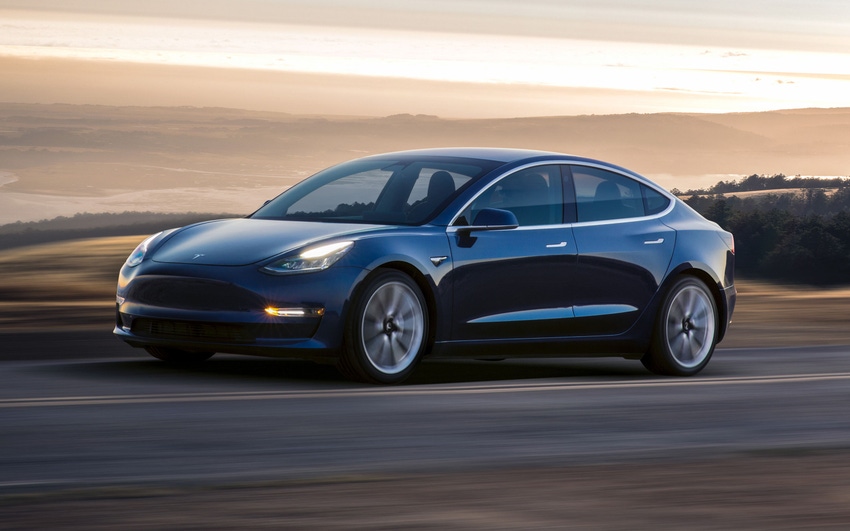Big Jump in EV Sales Seen for 2019
Tesla will see more competition from mainstream automakers.
February 7, 2019

It won’t be just a Tesla market anymore.
A new study from Navigant Research predicts a 50% jump in battery-electric vehicle (BEV) sales in 2019. Much of the growth, the company says, will come from mainstream automakers, including General Motors, Ford, Volkswagen, Hyundai, Kia, Nissan, Jaguar, Audi, Porsche, and others. “We’re definitely going to see more product coming from other manufacturers over the course of this year and into 2020,” Sam Abuelsamid, senior analyst for Navigant, told Design News. “It’s unlikely that Tesla will be able to continue dominating the market the way they have been.”
Navigant’s new study predicts that BEV sales in the US will rise to 398,000 in 2019, up from 258,000 in 2018 (approximately 1.5% of overall vehicles sales). Plug-ins (which includes BEVs and plug-in hybrids) will make a similar jump to 582,000.
Moreover, plug-in sales are expected to rise globally, all the way out to 2030. The study, which will be released next week, calls for global plug-in sales to hit 2.5 million in 2019, 8.5 million in 2025, and 25 million in 2030. Navigant author Scott Shepard referred to 2030 as an “inflection point,” saying that plug-ins would by then make up 18% of the worldwide auto market.
The growth is partially attributed to the fact that more mainstream automakers are joining the electric ranks, with many introducing longer-range BEVs as soon as this year. Kia, for example, is rolling out the Niro EV and the Soul EV, while Hyundai will begin selling the Kona EV. Nissan’s Leaf Plus, featuring a big boost in range, is expected soon. In the premium segment, Audi e-Tron is also coming, as is the Porsche Taycan, while Jaguar has already begun selling its I-Pace EV. Meanwhile, GM, Ford and possibly Fiat Chrysler are also expected to unveil electric vehicles later this year.
|
Sales of Tesla’s Model 3 dropped sharply in January, partly due to the reduction in tax credits. (Image source: Tesla, Inc.) |
The mainstream growth represents a sharp contrast to 2018, when Tesla Inc. had the top-three-selling electric vehicles, with no other manufacturer coming close in terms of raw sales numbers. More than 139,000 Tesla Model 3s were sold last year, while the Tesla Model X and Model S came in second and third at 26,100 and 25,745 respectively, according to figures from InsideEVs. The largest-selling electric vehicle produced by any other manufacturer – GM’s Chevy Bolt EV – came in at about 18,000 units.
Cost Is Still the Key
This year, however, could be different. While Tesla is still expected to still be the top-selling electric automaker, its sales are likely to be affected by the partial loss of tax credits. On January 1st, Tesla’s EV tax credit fell to $3,750 per vehicle, down from $7,500 last year, due to the fact that its cumulative sales broke the 200,000-mark in 2018.
Sales of the Model 3 subsequently fell sharply in January, partly because of the smaller credit and partly because the company has not yet delivered on its promise to sell the vehicle for $35,000. “Many of the people who can afford a $35,000 car haven’t been able to step up to a $50,000, $60,000 or $70,000 Model 3,” Abuelsamid said. “Until Tesla can offer such a car to customers, it will probably struggle to keep up the same sales pace.”
Tesla responded in January by announcing that it would lay off 7% of its workforce, presumably in an effort to make the Model 3 more profitable at a lower selling price. Yesterday, the company said it is lowering the entry-level price of the Model 3 Mid Range to $42,900.
RELATED ARTICLES:
Even if the company fails to cut the price of the Model 3 to $35,000, however, no other individual manufacturer is expected to match Tesla’s sales in 2019. Most are ratcheting up production very carefully, for fear of over-committing to a market that is still not readily absorbing electric cars.
“They struggle to break even on these vehicles anyway, and they don’t want to have to offer discounts,” Abuelsamid said. “It doesn’t make sense to offer a discount on models where you’re already losing money.”
Abuelsamid said the key to further growth is to drive down costs further, and to offer vehicle styles that resonate with consumers. Sedans, he said, are a declining segment, while crossovers, SUVs, and pickups are growing in popularity.
“When they can get a crossover into that segment, you’ll see Tesla’s sales start to grow again,” he said.
Senior technical editor Chuck Murray has been writing about technology for 35 years. He joined Design News in 1987, and has covered electronics, automation, fluid power, and auto.
ESC BOSTON IS BACK! The nation's largest embedded systems conference is back with a new education program tailored to the needs of today's embedded systems professionals, connecting you to hundreds of software developers, hardware engineers, start-up visionaries, and industry pros across the space. Be inspired through hands-on training and education across five conference tracks. Plus, take part in technical tutorials delivered by top embedded systems professionals. Click here to register today! |
About the Author(s)
You May Also Like



.jpg?width=300&auto=webp&quality=80&disable=upscale)

